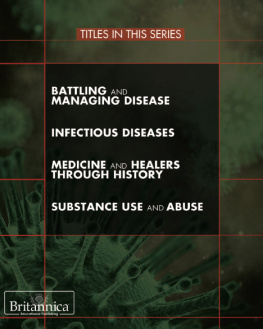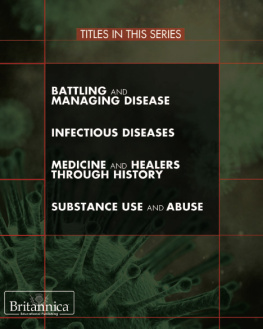Like any other synthetic work intended as a textbook or for the general reader, this book depends heavily on the scholarship of others, and I would like to acknowledge my great debt to them. One book that I would have liked to have made more use of was Howard Phillips and David Killingrays volume on The Spanish Influenza Pandemic , which I did not receive until my manuscript had reached the copy-editing stage. Although I have referred to this book in chapter 7, I was unable to incorporate its many insights. Readers with a particular interest in the influenza pandemic would do well to consult this book, which contains some of the best work yet produced on the subject.
I am lucky enough to know or to have known many of the scholars who produced the original scholarship upon which this book is based, among whom I would like to mention the late Roy Porter, who provided me with invaluable advice when I began writing this book. I owe an even greater debt to my friend and former colleague Michael Worboys, who has probably done more than anyone else to influence my thinking about disease. I would also like to thank Loreen Salleh and the referees for their helpful suggestions, and the people at Polity for their assistance, especially Jean van Altena for her excellent copy-editing. Finally, I would like to thank my family, friends and colleagues for their forbearance and support.
Introduction
Today, every country may be regarded as modern in its most fundamental respects. The very fact that we can compare a countryseconomic performance, its population and its mortality figures is evidence of this. Virtually every nation on earth is organized in a way that enables its resources to be measured, monitored and evaluated in other words, a form of organization that is typically modern. Countries that have undergone modernization may continue to contain pre-modern social arrangements or ideas, but only if they are compatible with the key elements of modernity.
Some may object that modernity is now a thing of the past, and that we are living in a postmodern world in which reason is no longer the guiding light and in which technology has lost its redemptive power. But while there are some reasons to see the recent past as distinctive, a historian of the long term may be more cautious. From the Renaissance onwards, successive generations of intellectuals have found the need to label their own times as different or special. Like Agnes Heller, I think it makes more sense to see postmodernism not as something that comes after modernism but as a critical, reflective tendency within it; a tendency that comes to the fore from time to time, questioning our ability to understand the world and our capacity to make it after our own image. In any case, it would be a mistake to exaggerate the changes that have occurred over the last two decades or so, as there is little sign of any fundamental shift in patterns of social organization. For good or ill, we are still very much part of the modern world.
Modernity is clearly a problematic concept, and there may be drawbacks to using it as a central theme for a book on the history of disease; nevertheless I believe, like Fernand Braudel, that a general history requires an overall model, good or bad, against which events can be interpreted. I aim to show that disease was central to the development of modern states and their machinery of government. From the Renaissance onwards, the control of disease became one of the most important functions of the state, along with the protection of its people from external aggression. Thus the threat of plague and other diseases met with co-ordinated state action in the form of quarantine, medical relief, isolation of victims, and measures to cleanse the environment. One cannot entirely discount humanitarian motives for these measures, but the growth of state activity had much to do with a new perception of the economic and military value of the population. This perception may, itself, have owed much to the depredations of plague, which increased the scarcity and price of labour. Public health measures also developed as means of controlling potentially dangerous or unruly elements within society, such as soldiers, beggars and prostitutes, all of whom were stigmatized as bearers of disease. The scale and scope of these measures widened considerably in the coming years, with the state aiming to maximize the potential of its population.
At numerous points, the history of disease also illuminates the growth of capitalism and its corollary, the formation of a new kind of class society. For one thing, disease rapidly became a marker of class: mortality differed greatly among social groups, as did the kinds of disease they tended to suffer from. In the Renaissance and for much of the seventeenth century, plague appeared to show a preference for the poor, rather like cholera in the nineteenth century. Gout, by contrast, was a disease of luxury and a marker of wealth and status; and disease is still one of the most poignant indications of a world divided by inequalities of wealth and opportunity. In rich, Western countries, most people live well beyond seventy years of age and die from heart disease, cancer or degenerative diseases. In the poor countries of Asia, Africa and Latin America, life expectancy is far lower, with many dying in infancy from infectious diseases and, increasingly, from AIDS and AIDS-related illnesses. There, the vast majority of people are denied the basic sanitary and medical provisions of those who inhabit the developed world.
Another aspect of economic development that looms large in this book is the global expansion of the market economy and of capitalist systems of production. This process began in the sixteenth century with the colonization of parts of Asia and most of central and southern America by the Spanish and the Portuguese, and was boosted during the seventeenth century with the arrival of commercial fleets from Holland, England and France. During the eighteenth century, these trading concerns began to transform themselves into territorial powers and to establish dominions in parts of South and South-East Asia. The trading companies were gradually brought under stricter control, and their territories came to be administered directly by European states. In the nineteenth century, there was a fresh wave of colonial expansion, most notably in Africa, from the 1880s. Alongside these formal colonies, European countries enjoyed unequal terms of trade with poorer, independent nations that formed part of an informal, commercial empire. With the demise of formal colonial rule in the second half of the twentieth century, the informal empire of old set the pattern for new relationships between rich and poor countries. Transnational companies also came to exert a tremendous influence over the economic policies of independent nations, which feared the withdrawal of capital investment.














